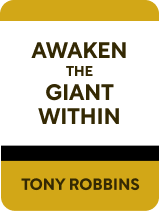

This article is an excerpt from the Shortform book guide to "Awaken the Giant Within" by Tony Robbins. Shortform has the world's best summaries and analyses of books you should be reading.
Like this article? Sign up for a free trial here .
Looking for Awaken the Giant Within exercises? How can you apply the key points of the book to your own life?
In Awaken the Giant Within, Tony Robbins provides empowering insights and strategies to help you take control of every aspect of your life, from your emotions to your finances. Our Awaken the Giant Within exercises will help you put these principles into practice, improving your mindset, relationships, and well-being.
Keep reading to find the best Awaken the Giant Within exercises.
Awaken the Giant Within Exercises
In Awaken the Giant Within, Tony Robbins provides the tools you need to transform your life for the better. From the power of your decisions and beliefs to the importance of your posture, Robbins covers the most powerful ways you can improve your well-being.
The following Awaken the Giant Within exercises will help you apply the lessons of the book to your own life.
Change Your Life Through Decisions
Reflect on how you can use the power of decision-making to transform your life.
- Describe one decision you’ve put off making. Why have you procrastinated making this choice?
- Make the decision right now. What did you decide?
- What is the first action you can take toward executing this decision?
- How will you ensure that you take this first step today?
- How will you ensure that you continue to make steady progress toward fully implementing this decision?
Evaluate Your Associations
Take the first steps toward correcting negative associations that are holding you back.
- What is one thing that would improve your quality of life, but that you’ve been putting off implementing? Why have you been putting it off?
- What pain do you associate with implementing this change? (Even if the pain is as simple as making time in your busy day, identifying this will give you insight into what obstacle has been preventing your progress.)
- What pleasure have you experienced from not changing your behavior? (Often, we put off change not just to avoid pain, but also because we get some pleasure from your current behavioral pattern. For example, some smokers are reluctant to quit because they enjoy the social aspect of cigarette breaks. The only way to truly reform is to find a way to still feel this pleasure from more positive behaviors.)
- What are the negative consequences of not correcting your behavior? How does contemplating these consequences make you feel? (Exploring the negative emotions you’ll feel if you continue your bad habits is critical in pushing you to change them.)
- List all the short-term and long-term benefits you’ll gain if, right now, you implement the change you’ve been putting off.
Control Your State
Brainstorm actions you can take to change your state anytime you want.
- List all of the emotions you experienced today, and the situations that triggered those emotions.
- List an emotion you’d like to regularly experience that you didn’t today.
- What kinds of postures, gestures, and other physical means can you use to bring on the emotion you want to incorporate into your daily life? (For example, if you want to feel more joy, make a point of smiling and laughing more often.)
- How can you manipulate your submodalities to elicit that emotion? (For instance, if you want to feel more joy, and you have a visual modality and positive associations with light, you may benefit from making your workspace brighter with an additional lamp.)
Assess Whether You’re Using Empowering Language
Evaluate and reform your habitual language to empower yourself.
- Think of the last problem you faced, big or small (this could even be discovering that you’re out of milk after pouring a bowl of cereal). What’s the first question that comes to mind when you think of that problem? (For example, “Why does my roommate never take the initiative to replace things when they run out?”)
- What is a more empowering question you can ask yourself instead? (For instance, “How can my roommate and I work out a system to let each other know when things run out?”
- Still thinking about this recent problem, what word would you use to describe how it made you feel?
- How could you use Transformational Vocabulary to rephrase that feeling and reduce its impact on you? (For example, instead of “irritated” you could say that you were “a bit ruffled.”)
Set Goals for Your Compelling Future
Gain the motivation to set goals and work toward them by reflecting on what your life is like now compared to five years ago.
- Reflect on your life five years ago. For each of the following categories, give yourself a score from 0 to 10, based on how well you were aligned with your ideal quality of life in that area. Write a sentence explaining each score. Categories: Career, finances, living environment, social life, relationships, mental, emotional, spiritual life, attractiveness, physical
- Do the same exercise—giving yourself a score and writing a brief explanation for each category—to reflect your life today.
- Compare your two sets of scores. What are two things that stand out to you? (For instance, in which category have you made the most progress in getting closer to your ideal? In which category have you stagnated or even backslid the most?)
- Do the same exercise to reflect on what you want your life to be like five years from now, assigning each category a score and writing one sentence to describe where you’d like to be. (For example, could you achieve a 10 and reach your ideal level of physical health and fitness? What would that entail?)
- Based on what you’ve just written, what are two or three goals you can set right now to work towards your five-year vision?
Evaluate Your Values
Reflect on how you prioritize some of your values and how this hierarchy affects your life.
- Describe a dilemma you recently faced, and how you decided to solve it.
- What were the conflicting values in this dilemma?
- Which value guided your ultimate decision?
Think about the implications of prioritizing this value above the other, conflicting value. How does this hierarchy shape your life on a larger scale? (For instance, in what other situations have you prioritized this value over the other? What were the effects of this?)
Minimize Negative Emotions
This exercise will draw your attention to your current emotional patterns so that you can use the strategies above to alter them:
- Write a list of every emotion you experience in a typical week.
- List the triggering situations and events beside each emotion.
- Circle or star all of the negative emotions on your list, and revisit the list of action signals in Part 1 to decode each of these emotions.
- Using that insight, develop a solution-oriented plan for responding to each of these action signals, which will quell the negative emotion. For example, if you frequently feel frustrated with your colleagues for not carrying their weight, remember that frustration is a signal that you need to change your approach. Make a plan to change your question from “Why aren’t they helping?” to “What can I delegate?” and ask for help.
- Throughout the day, focus on replacing your negative emotional patterns with your new, empowering patterns. The more consistently you do this, the more you will condition this change.
Find Ways to Give Back
Come up with a plan to make contribution a part of your life:
- What is one cause that you care deeply about? Why do you care about it?
- How could you use your unique skills to contribute to this cause? (For example, perhaps you’re a great listener and could spend time with assisted living residents, or maybe you’re a lawyer who could offer free legal advice to a nonprofit.)
- How many hours can you commit to this cause each month?
- What can you do today to set your plan to contribute to the cause in motion? (For example, you could call the organization you want to work with and schedule a date and time for you to volunteer.)
Use the above Awaken the Giant Within exercises to apply the insights of the book to your own life.

———End of Preview———
Like what you just read? Read the rest of the world's best book summary and analysis of Tony Robbins's "Awaken the Giant Within" at Shortform .
Here's what you'll find in our full Awaken the Giant Within summary :
- How to make transformational changes to your life through small adjustments
- How you create your destiny every time you start a sentence with “I am…”
- Strategies to take control of your thoughts and emotions






